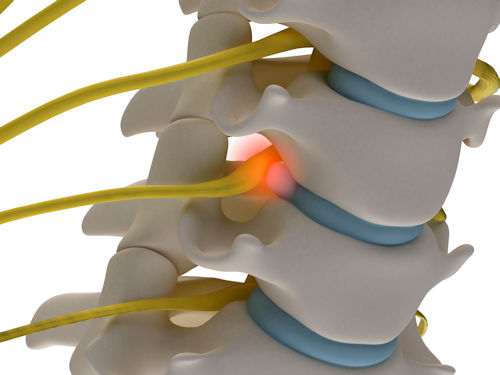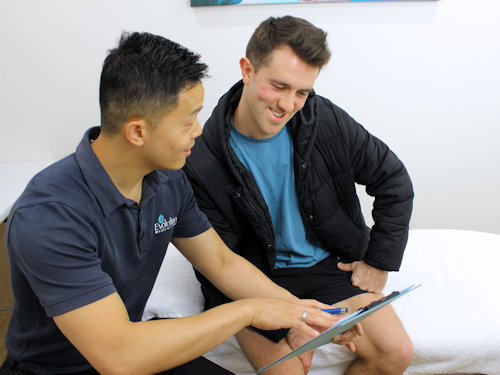Back Pain is extremely common, most people will experience back pain at least once throughout their lives and it can range in the way it impacts our life. Back pain can be mild, nagging pain or severe debilitating pain which can cause radiating discomfort or sensation into other parts of the body. This can lead to a decreased ability to physically lift objects, walk, or even stand and sit for prolonged periods.
When it comes to back pain, the intensity of pain is not always an indicator of how severe the situation is. Sometimes pain can be extremely intense and come on quickly, often this same pain can resolve quickly with minimal intervention necessary. An example of this is a case of wry neck, where sleeping awkwardly can cause pain related to muscular spasming. Other times, back pain can be more extreme and develop slowly over time which can lead to structural changes to the spine such as osteophytes (bone spurs). This can lead to long-standing pain and decreased physical capacity that is more resistant to treatment.
In most cases, back pain will be acute and last for a few days to weeks, although in some situations, it may last longer and become chronic. Chronic cases can last for months, years or even for some people it may be ongoing until appropriate help is sought to resolve the painful situation.
The Structures of Our Back
In order to explain what types of treatment are going to be beneficial and when they should be used, let’s dive into explaining the structures of the back, how they interconnect and where they commonly cause issues!
Our back is primarily categorised into 2 areas:

1. The Upper Back
Comprised of the thoracic spine and is attached to our rib cage. This leads to a decreased range of movement throughout the upper back but is fantastic for structural stability due to the rigid nature of our ribs and connective tissue.
Although less common than Lower Back Pain, Upper Back Pain is extremely common, with approximately 10% of men and 20% of women suffering from upper back pain at some point in their lives.
2. The Lower Back
Made up of spinal bones called ‘vertebrae.’ This is much like the thoracic spine but stronger in its formation to improve the range of movement in the lower back and to reduce the incidence of injury.
The spine is a structure of weight-bearing vertebral bodies, which are separated by shock-absorbing ‘Inter-Vertebral Discs.’ These are made up of a fibrous exterior and gel-like interior which gives the spine mobility. Behind this is the spinal cord where spinal nerves exit the spine to supply innervation (nerve supply) to and from the rest of the body. The transverse and spinous processes (knobbly parts of the spine) are located at the sides and rear of the spine. These both act as attachment sites for muscles that protect the spinal cord and spinal nerves from injury.

Causes of Back Pain
1. Poor Posture
This is an extremely common cause of upper back pain. This can be due to common postural modifications, such as sitting at a desk or computer for prolonged periods of time. The muscles become tightened and shortened leading to long-term postural changes, even when not in these positions. The impact of this is that we become out of balance. Gravity pulls our body down and the upper back muscles are put under constant strain which leads to fatigue, pain, and accumulation of inflammatory factors in the upper back.
2. Traumatic Injury
At times, pain after an injury is obvious as it develops immediately after the event and at other times the pain may develop the next day or even weeks later. Common examples of traumatic injuries include car accidents, slipping and falling, lifting incorrectly and work-related injuries.
3. Repetitive Strain injuries
Overusing back muscles is another common cause of upper back pain. This typically occurs due to repetitive movements over time such as sitting at a desk, bending over, lifting boxes, or lifting heavy weights. These movements can lead to muscular strain and inflammation.

These causes of back pain may lead to conditions such as:
1. Myofascial Pain
This is pain stemming from the muscles and tendons in the back which we call the fascial system.
2. Osteoarthritis
Back Pain is not always due to muscular issues; it may be related to the bones and joints.
This can be caused by either age or repetitive straining. The cartilage that cushions and protects our joints may wear down leading to inflammation and pain. This degenerative condition is called Osteo-Arthritis (Osteo = Bone, Arthro = Joint, Itis = inflammation).
Osteoarthritis may eventually lead to cartilage between the bones completely wearing away, causing the bones to rub together, which leads to deformed growth of bony spurs on the bones called osteophytes. This may lead to compression of the spinal nerves exiting the spine, causing numbness, or tingling in the arms and legs.
3. Intervertable Disc Bulge/Herniation
Intervertebral discs are made up of a fibrous exterior, called the ‘annulus fibrosus’ and a gel-like interior known as the ‘nucleus pulposus’. Intervertebral discs allow our spine to flex and bend and prevent our vertebrae from rubbing against each other.
When excessive pressure is placed on the spine, it can lead to ‘bulging’ or ‘herniation’ of an intervertebral disc, where the fibrous exterior has ruptured. This can be caused by vertical compression, such as when jumping from a height and landing ‘straight-legged’ or more frequently when the spine is bent forward picking up a heavy weight during a deadlift movement with poor form.
In both cases, the disc injury may cause impingement of spinal nerves leading to numbness, pain, tingling, or decreased physical strength in the arms or legs.
Treatment Approaches
There are several approaches to dealing with back pain and the most common approaches typically involve:
1. Medications
Non-Steroidal Anti-Inflammatories (Paracetamol, Ibuprofen, Voltaren), Pain Relieving Opioid drugs (Endone/Tramadol), Muscle Relaxants & Anti-Depressants
2. Surgery
Which may include partial or full discectomies, fusion, or other techniques, especially when dealing with structural injuries, such as intervertebral disc bulging/herniation.
3. Relaxation Techniques
Cognitive Behavioural Therapy, Meditation & Acupuncture to improve mental focus and mood which is attributed to decreasing pain perception.
4. Exercises
Core & Back strengthening exercises that may be part of general strength & conditioning programs, such as Pilates or yoga.
5. Complementary Medicine
Acupuncture, Cupping, Chiropractic, Massage & Physical Therapy.
Our Best Practice for Back Pain Treatment
At our clinic, to achieve the best results for back pain, it’s important we help our clients follow a step-by-step process. This may include a combination of treatment approaches at different stages to achieve results quickly. It will also ensure that the pain isn’t just temporarily relieved but resolved long-term.

Stage 1
The first stage of treatment for back pain is focused on reducing pain quickly. This may be achieved by decreasing inflammation, muscular spasming and pain perception through various mechanisms. Depending upon the nature of back pain, appropriate treatments to relieve pain through our clinic at this stage may include Acupuncture, Cupping therapy, Massage therapy, Auriculotherapy and Electro-Therapy. It’s also common that medications would be used at this stage and in extreme cases surgery may be needed.
Stage 2
Once initial treatment goals are achieved, it’s essential to address the underlying causative factors of back pain by strengthening weak muscle groups and correcting posture to stabilise back pain long-term. This stage of treatment typically involves appropriate exercise therapy in conjunction with ongoing, tapered-off stage 1 treatment as mentioned above.
Stage 3
Once pain is resolved through focused treatment and underlying factors have been addressed, it’s important to take onboard lifestyle changes. These could be in the form of exercise therapy or other relevant factors that a healthcare professional is able to advise on. This provides a lasting solution to your pain and actively improves your overall state of health.
That’s a Wrap!
Back pain remains to be the most prevalent injury clients at our clinic seek pain relief for. We know from experience delaying intervention can cause more harm and turn acute situations chronic if not attended to. In order to achieve the best outcome possible, seek advice early and follow the advice provided by your healthcare professional.
I hope that this has been helpful in developing your understanding of different types of back pain and how different approaches to treatment may be used to achieve the best results to alleviate your back pain.
If you have any questions, feel free to reach out to my team on (02) 4709 6727 and we will be glad to guide you on how to get your health back on track!

